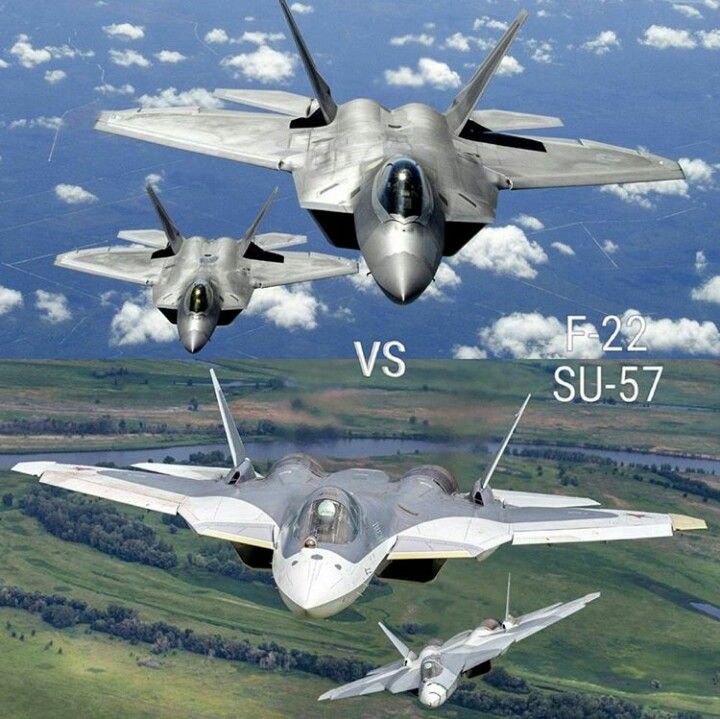F-22 vs Su-57
The comparison between the American F-22 Raptor and the Russian Su-57 Felon has sparked debates in defense circles for years. Both aircraft are fifth-generation stealth fighters designed for air superiority, yet they represent very different design philosophies and technological approaches. While the F-22 has already proven itself as a combat-ready platform, the Su-57 is still relatively new and in limited production. Examining their strengths, weaknesses, and roles provides insight into modern aerial warfare.
Design Philosophy and Stealth
The F-22, developed by Lockheed Martin, emphasizes stealth above all else. Its shape, internal weapons bays, radar-absorbent coatings, and minimal radar cross-section make it extremely hard to detect. This “first look, first shot, first kill” doctrine gives the Raptor a decisive advantage. In contrast, the Su-57, built by Sukhoi, prioritizes versatility and agility. While it does incorporate stealth features, such as angled surfaces and radar-absorbent materials, experts argue its radar signature is larger than that of the F-22. Russia’s focus leans more on maneuverability and multi-role capabilities rather than complete invisibility.

Avionics and Sensors
The F-22 is equipped with advanced avionics, including the AN/APG-77 Active Electronically Scanned Array (AESA) radar, which allows detection and tracking of enemy aircraft at long distances while maintaining low probability of intercept. Its sensor fusion provides pilots with unmatched situational awareness. The Su-57 uses the N036 Byelka radar system with multiple radar arrays, potentially offering 360-degree coverage. Russia claims its system can detect stealth aircraft, though independent analysts remain skeptical. The F-22’s combat record suggests its electronic warfare and sensor suite remain superior, at least for now.


Engines and Maneuverability
One of the Su-57’s most notable strengths is agility. Its engines, coupled with 3D thrust-vectoring nozzles, allow it to perform extreme maneuvers. This can provide advantages in close-range dogfights, a traditional Russian strength in aircraft design. The F-22 also features thrust-vectoring, though its designers focused more on blending maneuverability with stealth rather than extreme aerobatics. Both fighters are capable of supercruise—flying at supersonic speeds without afterburners. However, the Raptor’s Pratt & Whitney F119 engines give it superior sustained supersonic performance compared to the Su-57’s current engines, which are still undergoing upgrades.
Weapons and Combat Role
The F-22 typically carries AIM-120 AMRAAMs and AIM-9 Sidewinders in internal bays, ensuring stealth is maintained. It is optimized for beyond-visual-range (BVR) engagements, where stealth and radar superiority allow it to strike first. The Su-57, while also carrying weapons internally, is designed with larger bays and external hardpoints for versatility. It can deploy a wider range of air-to-air, air-to-ground, and even hypersonic missiles, reflecting Russia’s emphasis on a multirole fighter rather than a pure air superiority jet.
Operational Status and Numbers
The U.S. has around 180 operational F-22 Raptors, though production stopped in 2011. Despite its age, it remains the benchmark for fifth-generation fighters. The Su-57, meanwhile, only entered service in small numbers in 2020, with fewer than two dozen reportedly active as of 2023. Russia plans to increase production, but sanctions and funding issues may slow this effort.
Conclusion
In a direct confrontation, the F-22 likely holds the advantage due to its superior stealth, sensor fusion, and combat-proven reliability. However, the Su-57’s agility, versatility, and future upgrades mean it should not be underestimated. The Raptor represents technological dominance of the early 2000s, while the Felon symbolizes Russia’s ongoing attempt to catch up in stealth technology. Ultimately, the outcome of any clash would depend on strategy, pilot skill, and broader support systems rather than the aircraft alone.





